B.
PEOPLEText: Manami Okazaki
Walk around Athens, and one of the most salient features is the abundance of graffiti that covers a large proportion of the city, giving it a grungy post apocalyptic atmosphere, with layers upon layers of text, messages, and images on the sides of the dilapidated buildings.
Indeed graffiti is not new in Greece, and the word itself comes from the word Graphi, which means “to write”.
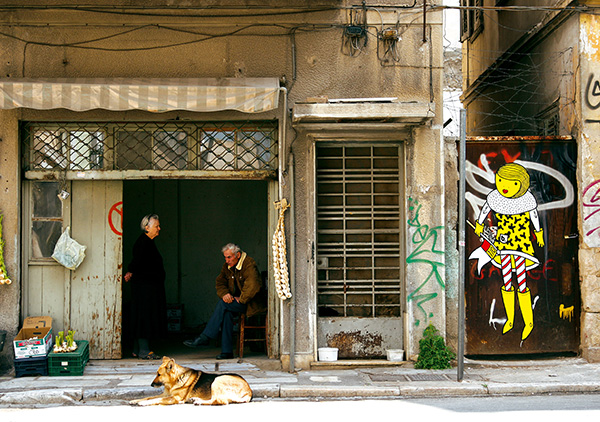
Whilst graffiti now is more a testimony to the influence of hip hop culture, and is widely considered in the public eye, as a form of vandalism, the graffiti of Athens is another way that people are reclaiming space, and personalizing the urban experience.
We met with b., a street artist who says he “creates life in the cities” and has his trademark yellow and black murals that wrap around doorways, and window frames of the decrepit buildings of the Psiri area, incorporating the architectural characteristics of the building into his creations.
His somewhat adorable work is like a logo in its simplicity, and he considers it necessary to have this kind of graphical impact to aggressively compete with the dominant images in the city- that of advertisers from whom he wants to reclaim the space.
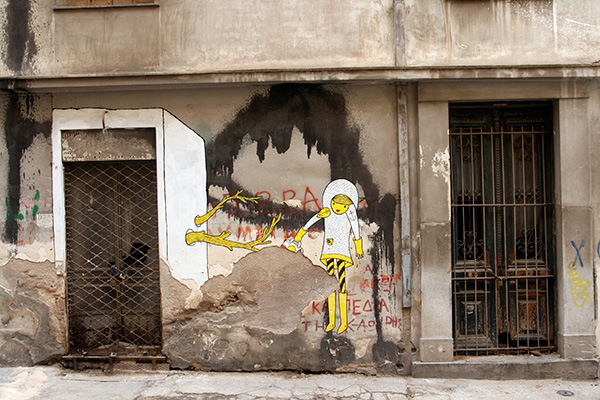
What’s the appeal of painting the street?
Instead of painting like, a white canvas? I try to live in the city first, and search for situations in the city, …people like little kids, gypsies and pikeys, who live there, and create a whole atmosphere, and then my work becomes part of that, so in a way it has life, it lives there. It’s not on a white canvas and only in my mind, it’s like I’m creating life in the city too, and I’m taking from the city inspiration, and I give it back with that. So from a white canvas I can’t take anything, I can’t interact easily.
When you look at a surface, what aspects of it make you want to use it as your canvas?
I try to find walls that have a little story, like, the Psiri area, (in Athens) with the Pakistanis, there was an old barber shop, and I can imagine what would have happened there 30 years before, so it gives me energy. You can see a little window, and I can transform that window into something else, so my work is parasitical to the city, it’s breathing,… like a virus.
I try to transform the buildings, in my way, the way that other people see the city and the buildings. You can play with your city, you can play with the walls, and what you can see, a little hole, a window, or a door, you can paint it pink, and do little eyes on it, and turn it into a big monster.
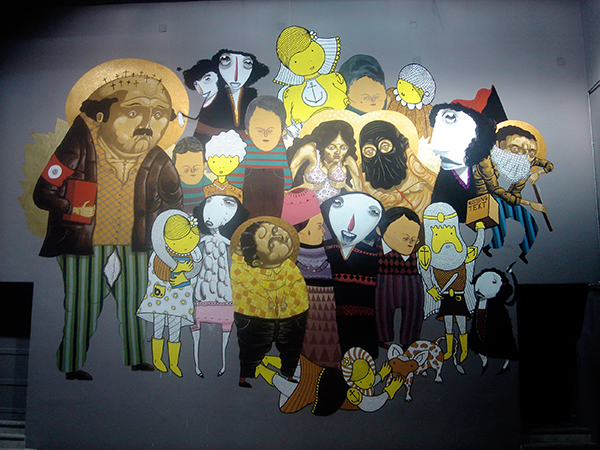
What remains is future, Patra Cultural Capital of Europe, Patra 2006
What is your favorite place to paint?
I’ve painted all over Europe, like in Amsterdam, Barcelona, in London and Berlin, …Berlin I have done a lot, but every city has its own energy, I can get inspired by different things in each place. Like, in London, there are many brick walls, and you can play with those bricks. I made little stairs, and the girls stand on the stairs. In London you can find old buildings easily.
In Beijing it was crazy cause I wanted to paint everywhere but I felt like I was destroying the image, it was so nice; I didn’t want to do anything. In London I’m not thinking that.
My favorite place is, Gite, (in Athens), inside alleys, back facades of the buildings where you see the life that is not on the street;-it’s more chaotic from the backside of every buildings. I like the chaotic atmosphere of the overdraft spaces.
Where else have you painted overseas?
Beijing, Dubai
What? Oh my god!…so risky!
I mean, Beijing is risky too, it was semi-legal what I was doing…
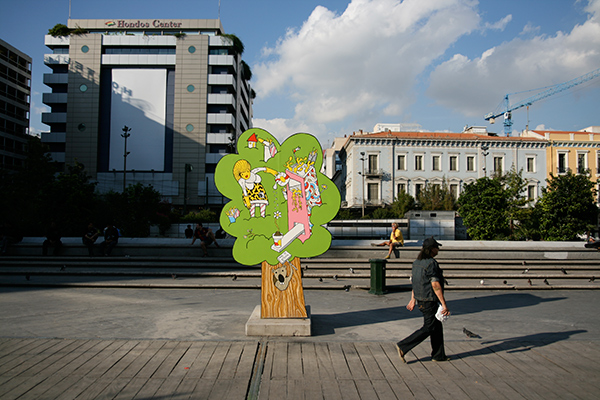
Let’s Draw Trees!, Green Design Festival, Athens 2008
Is Greece actually a good place for graffiti, are the police quite harsh?
The police think it’s vandalism; the situation is not easy to paint. I think that slowly in these five years the owners of the buildings, and the people who walk by are not negative, they say, Ok,…keep on doing it, …it’s nice.
They can recognize that you are doing something, and trying to make something good, you aren’t just writing your name and then you leave.
Are there many people doing artistic murals here or is it mostly tagging? ..There is tagging everywhere.
There is everything, there is a lot of tagging, but in the last years, you can see things that are not like the old graffiti style.
I read that political messages were scrawled on walls in the civil war during the Nazi occupation, and the 1967-74 junta..
Athens has a history of political graffiti and writing on the wall, during the war, and the military dictatorship. It was mostly begun as something political, but it wasn’t part of the hip-hop graffiti style that grew up in the 90s. I think in the 80s it was more team writing, like football teams…
Nice!..
Yeah …like hooligans and stuff
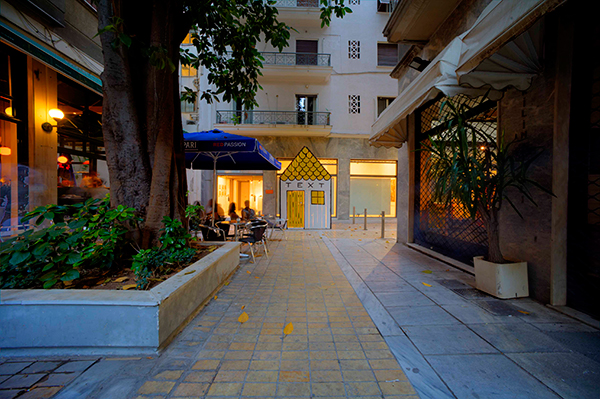
“Missing Text” – Solo exhibition
Have you always worked with duo-colors?
I’ve been using the yellow and black for five years now, when my tag became a logo and I started to think of my work as a brand virus in the city, compared to the other creators in the city who are the advertisers, mostly.
I had to do something that was equally or more aggressive compared to the logos of Vodafone or Coca cola. The logos, the brand colors and everything, have to be a brand identity, so ironically I played with that. I have a brand color and I’m saying to people ‘I cannot survive in a city that is built from multinational logos, and religious symbols’… My work has to be equally shown
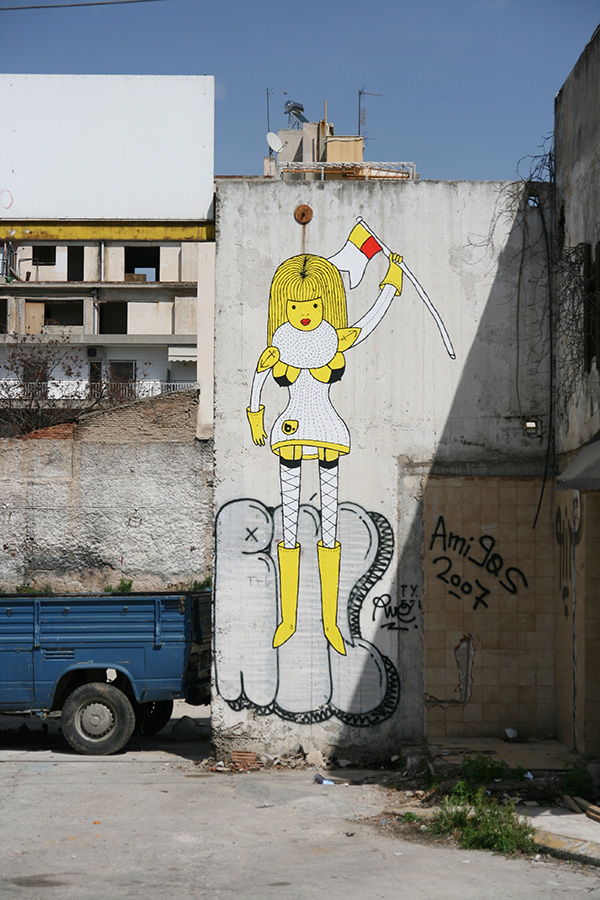
Why yellow?
I think I took yellow from the signs from the danger signs. I’ve done some pieces and you can see yellow and black stripes, and I like to draw attention from that. Afterwards the whole thing was incorporated,- it has to be yellow, it has to be a logo, and it has to have the logo on it, not just to draw something and to have the logo and the signature on the side.
Maybe it’s because the city is difficult; there are many graffiti artists, and you paint over and over again. You see tags, and when you want to draw on the tags, you have to make something that looks brighter, stronger, if you want to paint over this; you have to do even more, that is why I’m working with really bright colors and outlines. I have to take over the space.
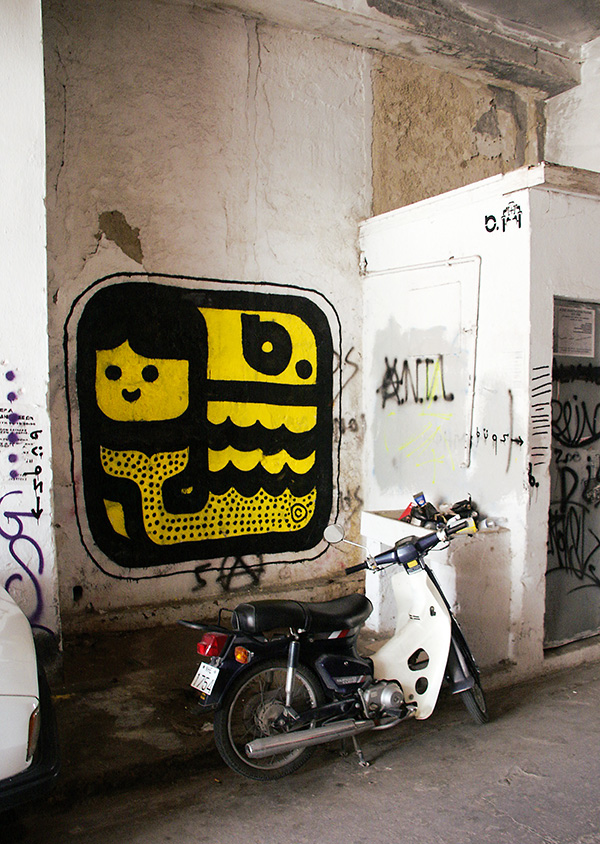
Are there buildings that are taboo? What don’t you touch?
I don’t go to areas like Kolonaki, like rich, developed areas. I like to go where the situations are under construction, there is a pressure, like the areas where I paint, you can see the rich people and the poor people, you can see the comparison. They are underdeveloped areas, but developing in an unpredictable way.
An example is in the street where my gallery is, which is like a building, which took some architectural award, like a really cool gallery which is like a white box with a really huge black door. In this street there are bordellos, and you can see there is a strong difference, y’know, a contradiction.
Do you ever do trains?
Yes, so that’s why I changed my tag;- I was raised in train yards, I was painting only in trains for I don’t know, how many years? It’s the most hardcore thing to do, it’s the most amusing thing to do, and you see it running everywhere.
It’s not like the situation with the walls, you run like hell, you run…you don’t talk with anybody. But I stopped that.
So, you started doing trains?
I started doing my first pieces, for like 6, 7 years, I was painting only trains and my style developed in trains.
Were you doing it on my own?
I was with my crew, you can go 2,3,4,… even 10,… depends on the yard, how big and easy it is.
What’s the most severe situation?, like, would you end up in prison?
Yeah I ended up there…taking a nap. Many times. You just sleep, I haven’t stayed in the police station jail for more than 2 days, if you go to jail, jail, forget about it!
Do you know anyone who has ended up in jail, proper?
No, I think they paid the fine and didn’t go…
But with the graffiti artists that you know of, do you think there are any characteristics that make it typically Greek?
I’m not sure, but Greece has full colors, bright colors, and it’s not so political, except Exarchia, where you can find anarchist stencils, which are not so developed, it’s not like Banksy. It’s anonymous, its cool, I like it, but it’s not like an artist, working on that in a continuous way, but I think its maybe now is the time that Greece forms the style of the scene.
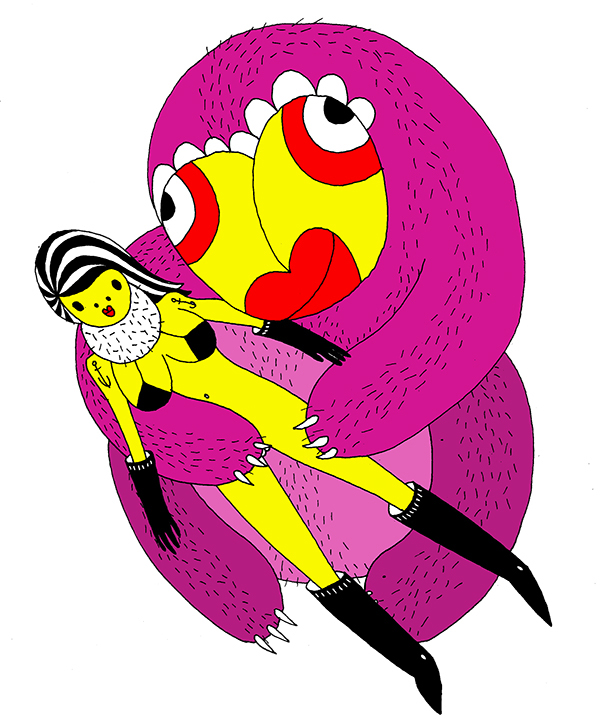
Do you ever have political messages in your work?
Y’know I say that only the act of taking the colors from your house and going into the city and writing is a political act. It’s enough to say that I’m not going shopping, or drinking a coffee, or going to the cinema, which is nice but I’m doing something else.
I’m working as an individual in the city and doing something that no one told me to do,…something I’m not supposed to do. So, in a way it’s political. But my work has something to say about the way the system of the advertisements and the advertisers have taken the city, and we must reclaim our public space.
It’s not the graffiti that says “We have to reclaim the city” in every aspect a lot of people I see in the street do things like that. Like, I see people juggling in the street. They are looking for space. In Exarchia they did it with a parking space and they turned it into a park.
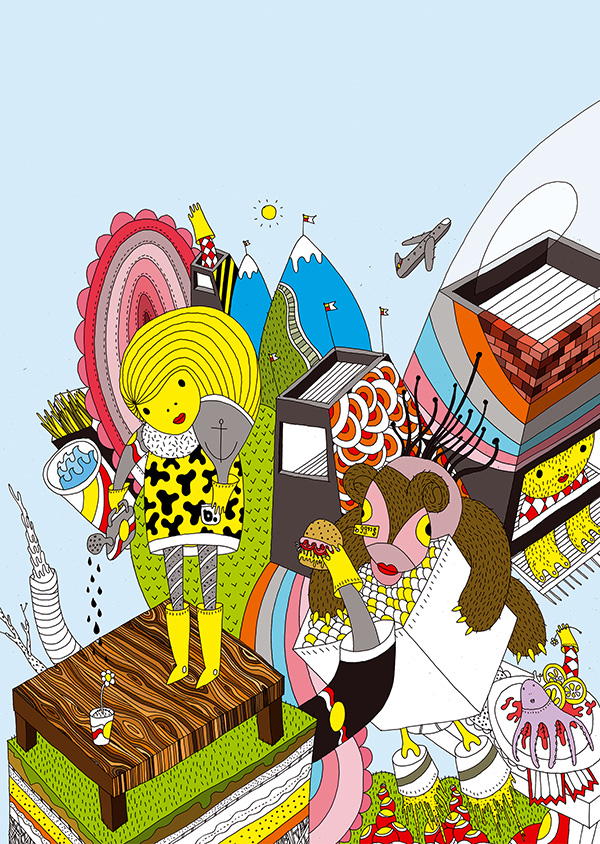
So you see what you are doing as a similar concept?
In a way yes, in a way I try to give the message that even the most urban, abandoned places can become familiar and you can make it like your home. You can stay there for 4 hours and paint. I see people who stay and drink beer under these places that have graffiti, and bring their girls, and I’m thinking that I’m making a new atmosphere. I’m giving new aspects of the city.
How did you get into just tagging?
I don’t know, I was just drawing on my school books,
Oh, god this is how every graffiti artist starts…their school books!
Ha, ha…I was painting on my desk, and I had to take peoples desks so I could continue painting them, then I started to paint walls in the school. The first graffiti that I saw and went crazy over was from Paladin, in 95.
He is like a legend, no one knew him in Greece and he came in 80-something and I saw that, and I said, I want to find a name and write my name too, cos I was painting whatever I was imagining, and I didn’t have a name. So that was the passage from painting as a kid to graffiti, the fact that I had a name and chose a tag.
How did you end up pro?
I starting painting in private jobs, and at some point I started painting in very rich people’s houses.
So I found some interest in that, doing graffiti in clean environments, like in luxury, in comparison with my work in the street. How did this happen? I’m not thinking that I am doing it professionally what I’m doing now. I’m taking the whole thing by the project, if I like the project even if it’s not for money, I will do it.
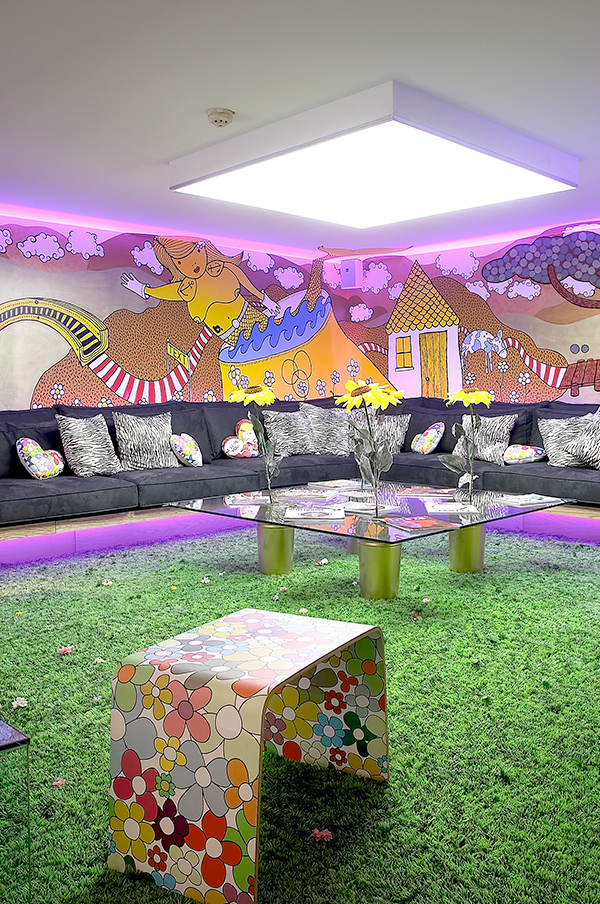
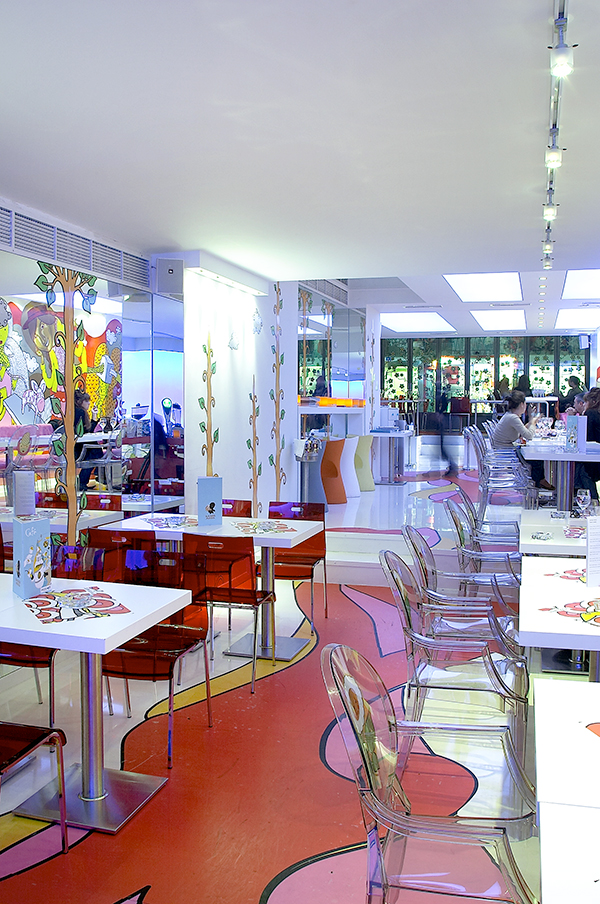
What kind of commissioned work have you done?
I’ve done like some rooms in a hotel, the Baby Grand hotel, and an Art cafe, and a biomedical institute.
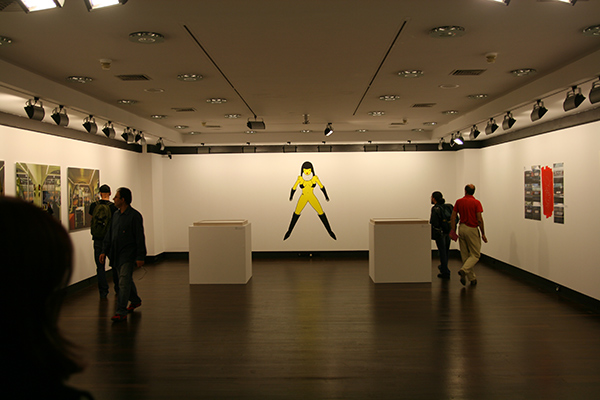
Everyday Stories, Hellenic-American Union, Athens 2007
Are galleries interested in Street Art?
We can say that the galleries are taking an interest and they have working street artists. I think that street art and graffiti are really close to people and it has became, how would you say? Popular? So the galleries had to get into it.
It’s difficult for a street artist cause it’s not like an artist. I’m not against doing exhibitions but it’s a difficult way to express yourself as a street artist in a gallery, you have to find your own terms and your way. It’s a totally different situation from the environment where a street artist is working, like an animal in the zoo, it doesn’t belong there.
Which graffiti artists do you respect?
Everyone in the city, …I like the work that is really involved with the wall and the city,, like taking a window and making it something else. When I see a piece that has interactivity with the city, normally I like it.
How often do you come out to the city to paint?
This year it was once a month. For 3, 4, 5, years I was painting 3, 4, times a week. It’s difficult to stay in the city, I have to do a hundred pieces and twenty will stay, so it’s hard, it’s really hard. You have to stay alive…survive….
Text: Manami Okazaki





